Examining Organisational Behaviour in Sainsbury's: A Case Study Report
VerifiedAdded on 2021/02/20
|18
|3366
|31
Report
AI Summary
This research project presents an executive summary and detailed analysis of organisational behaviour within Sainsbury's, a major supermarket chain in the United Kingdom. The study examines the importance of organisational behaviour, focusing on theories and models related to communication, culture, and motivation. It includes a company overview, primary and secondary research, and an analysis section. The research employs Handy's culture model, Maslow's motivation theory, and Weber's classic organisational theory to understand Sainsbury's practices. The findings are linked to real-world applications within the company, including employee motivation, communication methods, and organisational culture. The report covers various aspects like organisational culture, communication strategies, and approaches to motivating staff, providing insights into Sainsbury's operations and management techniques. The report also includes an introduction, literature review, methodology, findings, analysis, conclusion, references and appendices.
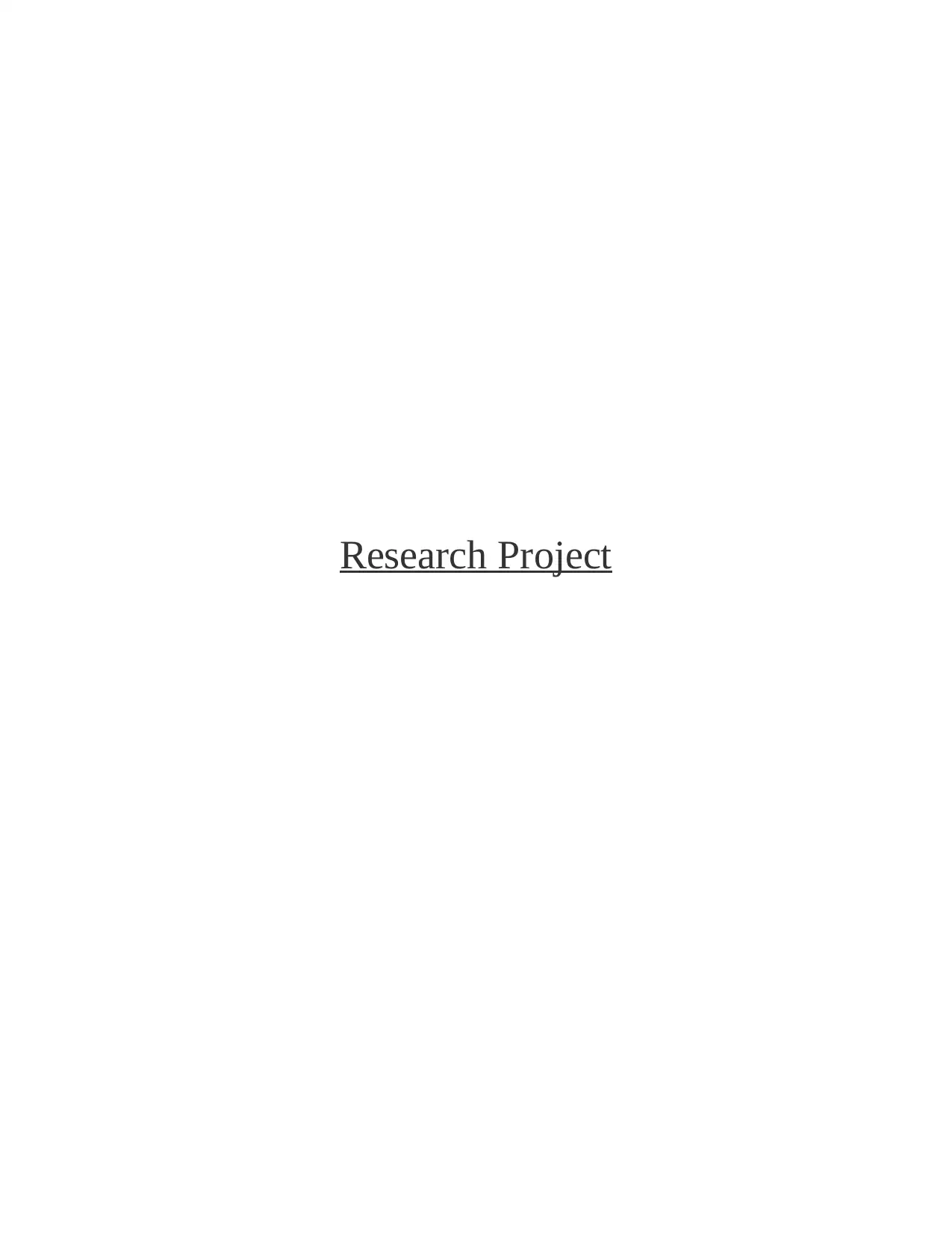
Research Project
Paraphrase This Document
Need a fresh take? Get an instant paraphrase of this document with our AI Paraphraser
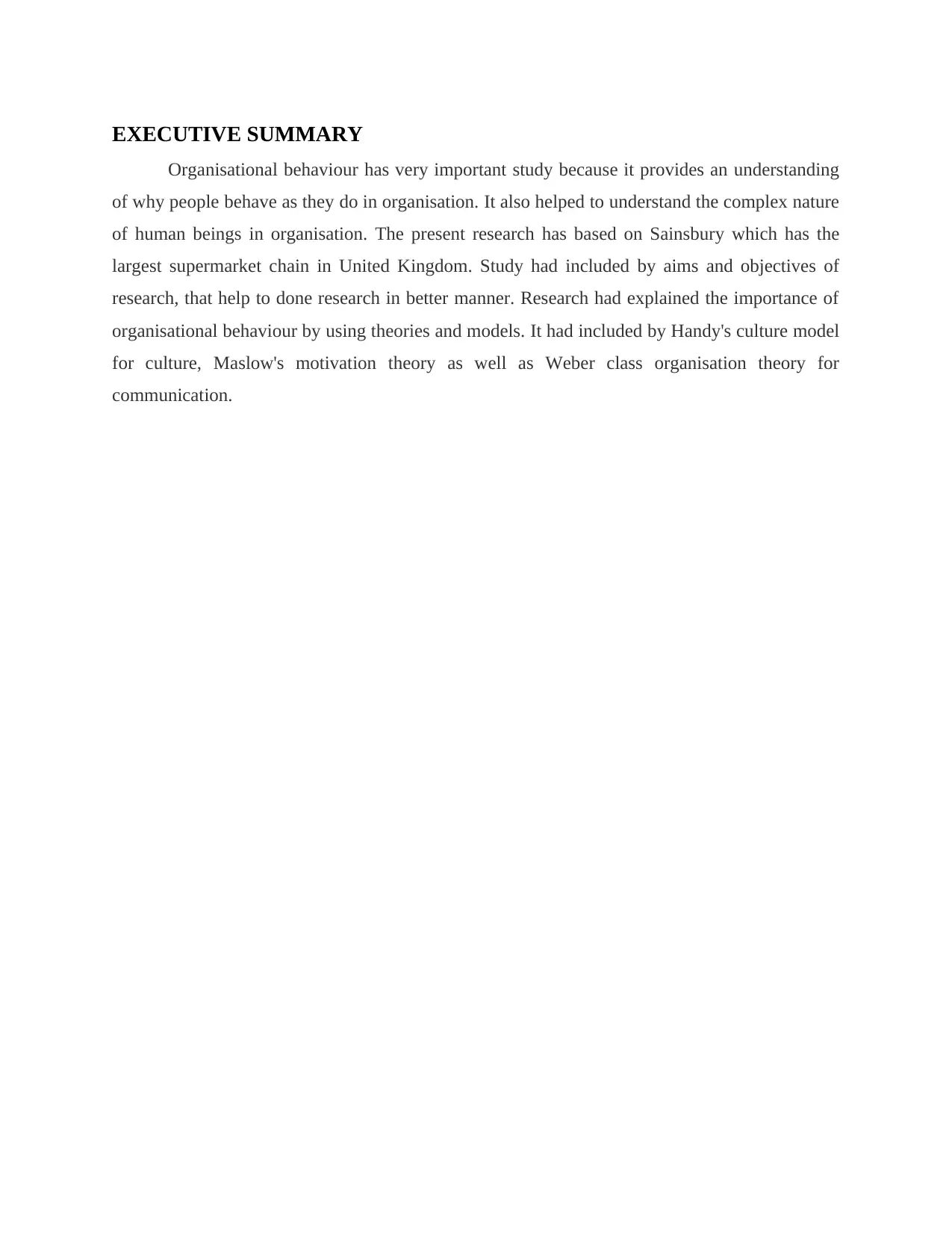
EXECUTIVE SUMMARY
Organisational behaviour has very important study because it provides an understanding
of why people behave as they do in organisation. It also helped to understand the complex nature
of human beings in organisation. The present research has based on Sainsbury which has the
largest supermarket chain in United Kingdom. Study had included by aims and objectives of
research, that help to done research in better manner. Research had explained the importance of
organisational behaviour by using theories and models. It had included by Handy's culture model
for culture, Maslow's motivation theory as well as Weber class organisation theory for
communication.
Organisational behaviour has very important study because it provides an understanding
of why people behave as they do in organisation. It also helped to understand the complex nature
of human beings in organisation. The present research has based on Sainsbury which has the
largest supermarket chain in United Kingdom. Study had included by aims and objectives of
research, that help to done research in better manner. Research had explained the importance of
organisational behaviour by using theories and models. It had included by Handy's culture model
for culture, Maslow's motivation theory as well as Weber class organisation theory for
communication.
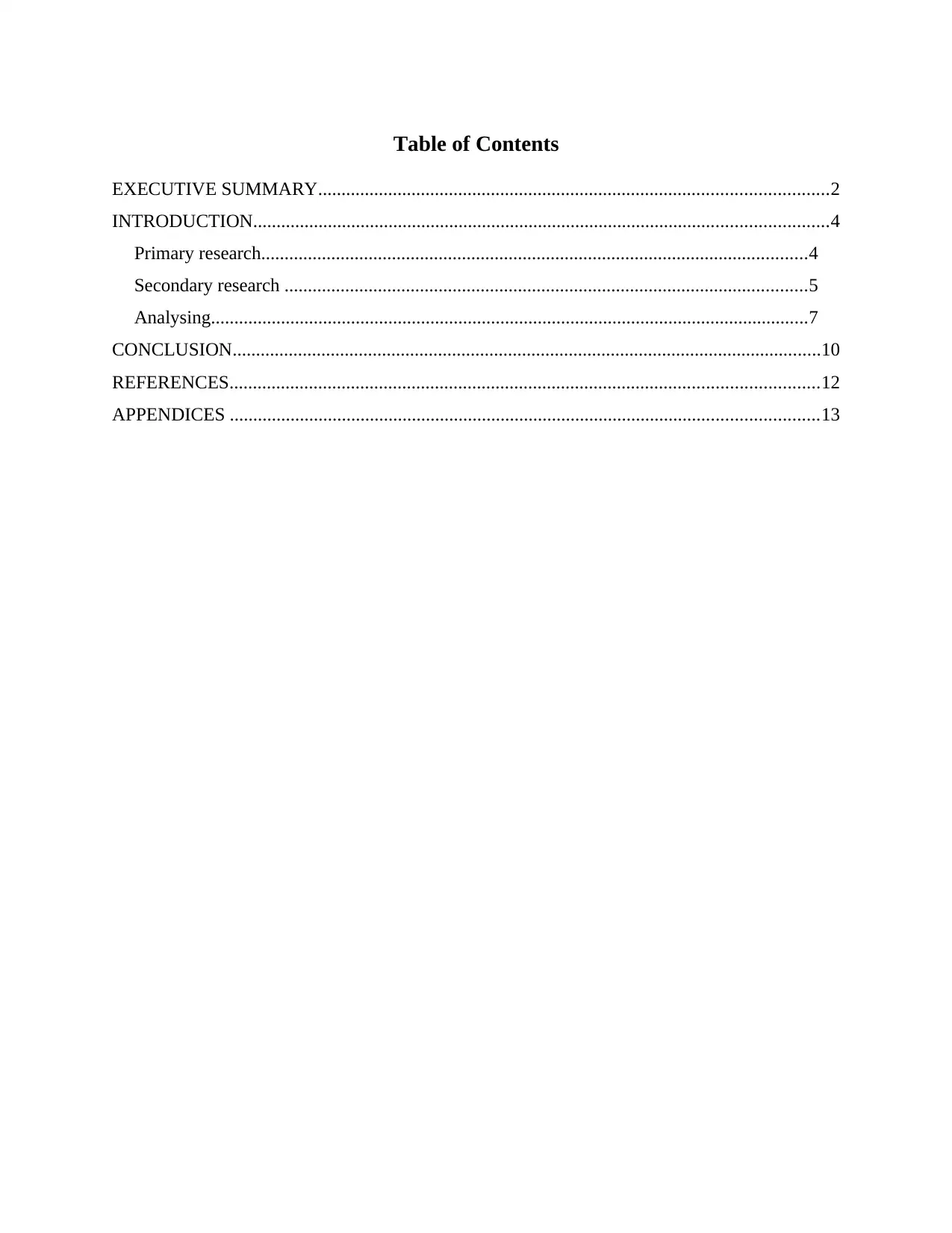
Table of Contents
EXECUTIVE SUMMARY.............................................................................................................2
INTRODUCTION...........................................................................................................................4
Primary research.....................................................................................................................4
Secondary research ................................................................................................................5
Analysing................................................................................................................................7
CONCLUSION..............................................................................................................................10
REFERENCES..............................................................................................................................12
APPENDICES ..............................................................................................................................13
EXECUTIVE SUMMARY.............................................................................................................2
INTRODUCTION...........................................................................................................................4
Primary research.....................................................................................................................4
Secondary research ................................................................................................................5
Analysing................................................................................................................................7
CONCLUSION..............................................................................................................................10
REFERENCES..............................................................................................................................12
APPENDICES ..............................................................................................................................13
⊘ This is a preview!⊘
Do you want full access?
Subscribe today to unlock all pages.

Trusted by 1+ million students worldwide
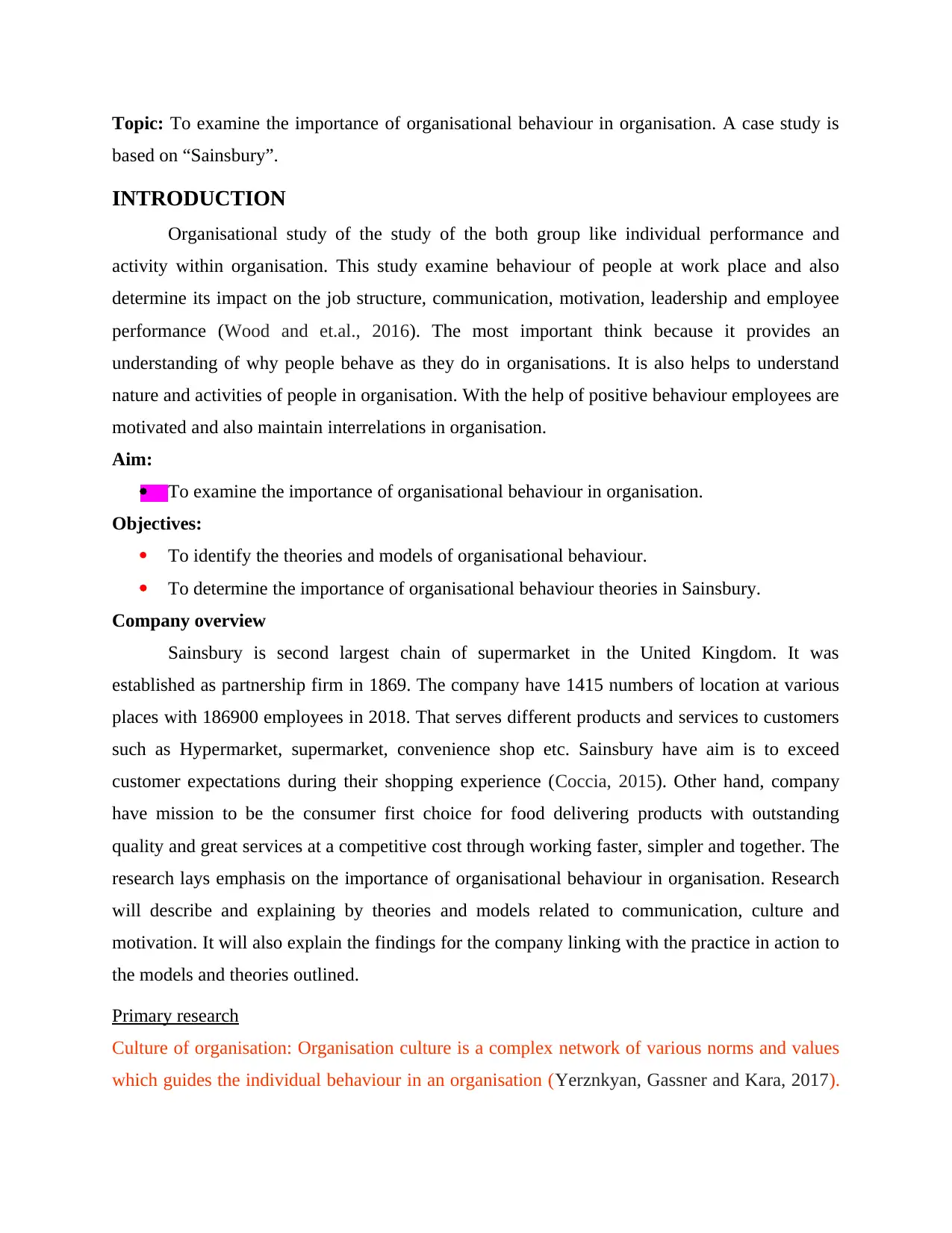
Topic: To examine the importance of organisational behaviour in organisation. A case study is
based on “Sainsbury”.
INTRODUCTION
Organisational study of the study of the both group like individual performance and
activity within organisation. This study examine behaviour of people at work place and also
determine its impact on the job structure, communication, motivation, leadership and employee
performance (Wood and et.al., 2016). The most important think because it provides an
understanding of why people behave as they do in organisations. It is also helps to understand
nature and activities of people in organisation. With the help of positive behaviour employees are
motivated and also maintain interrelations in organisation.
Aim:
To examine the importance of organisational behaviour in organisation.
Objectives:
To identify the theories and models of organisational behaviour.
To determine the importance of organisational behaviour theories in Sainsbury.
Company overview
Sainsbury is second largest chain of supermarket in the United Kingdom. It was
established as partnership firm in 1869. The company have 1415 numbers of location at various
places with 186900 employees in 2018. That serves different products and services to customers
such as Hypermarket, supermarket, convenience shop etc. Sainsbury have aim is to exceed
customer expectations during their shopping experience (Coccia, 2015). Other hand, company
have mission to be the consumer first choice for food delivering products with outstanding
quality and great services at a competitive cost through working faster, simpler and together. The
research lays emphasis on the importance of organisational behaviour in organisation. Research
will describe and explaining by theories and models related to communication, culture and
motivation. It will also explain the findings for the company linking with the practice in action to
the models and theories outlined.
Primary research
Culture of organisation: Organisation culture is a complex network of various norms and values
which guides the individual behaviour in an organisation (Yerznkyan, Gassner and Kara, 2017).
based on “Sainsbury”.
INTRODUCTION
Organisational study of the study of the both group like individual performance and
activity within organisation. This study examine behaviour of people at work place and also
determine its impact on the job structure, communication, motivation, leadership and employee
performance (Wood and et.al., 2016). The most important think because it provides an
understanding of why people behave as they do in organisations. It is also helps to understand
nature and activities of people in organisation. With the help of positive behaviour employees are
motivated and also maintain interrelations in organisation.
Aim:
To examine the importance of organisational behaviour in organisation.
Objectives:
To identify the theories and models of organisational behaviour.
To determine the importance of organisational behaviour theories in Sainsbury.
Company overview
Sainsbury is second largest chain of supermarket in the United Kingdom. It was
established as partnership firm in 1869. The company have 1415 numbers of location at various
places with 186900 employees in 2018. That serves different products and services to customers
such as Hypermarket, supermarket, convenience shop etc. Sainsbury have aim is to exceed
customer expectations during their shopping experience (Coccia, 2015). Other hand, company
have mission to be the consumer first choice for food delivering products with outstanding
quality and great services at a competitive cost through working faster, simpler and together. The
research lays emphasis on the importance of organisational behaviour in organisation. Research
will describe and explaining by theories and models related to communication, culture and
motivation. It will also explain the findings for the company linking with the practice in action to
the models and theories outlined.
Primary research
Culture of organisation: Organisation culture is a complex network of various norms and values
which guides the individual behaviour in an organisation (Yerznkyan, Gassner and Kara, 2017).
Paraphrase This Document
Need a fresh take? Get an instant paraphrase of this document with our AI Paraphraser
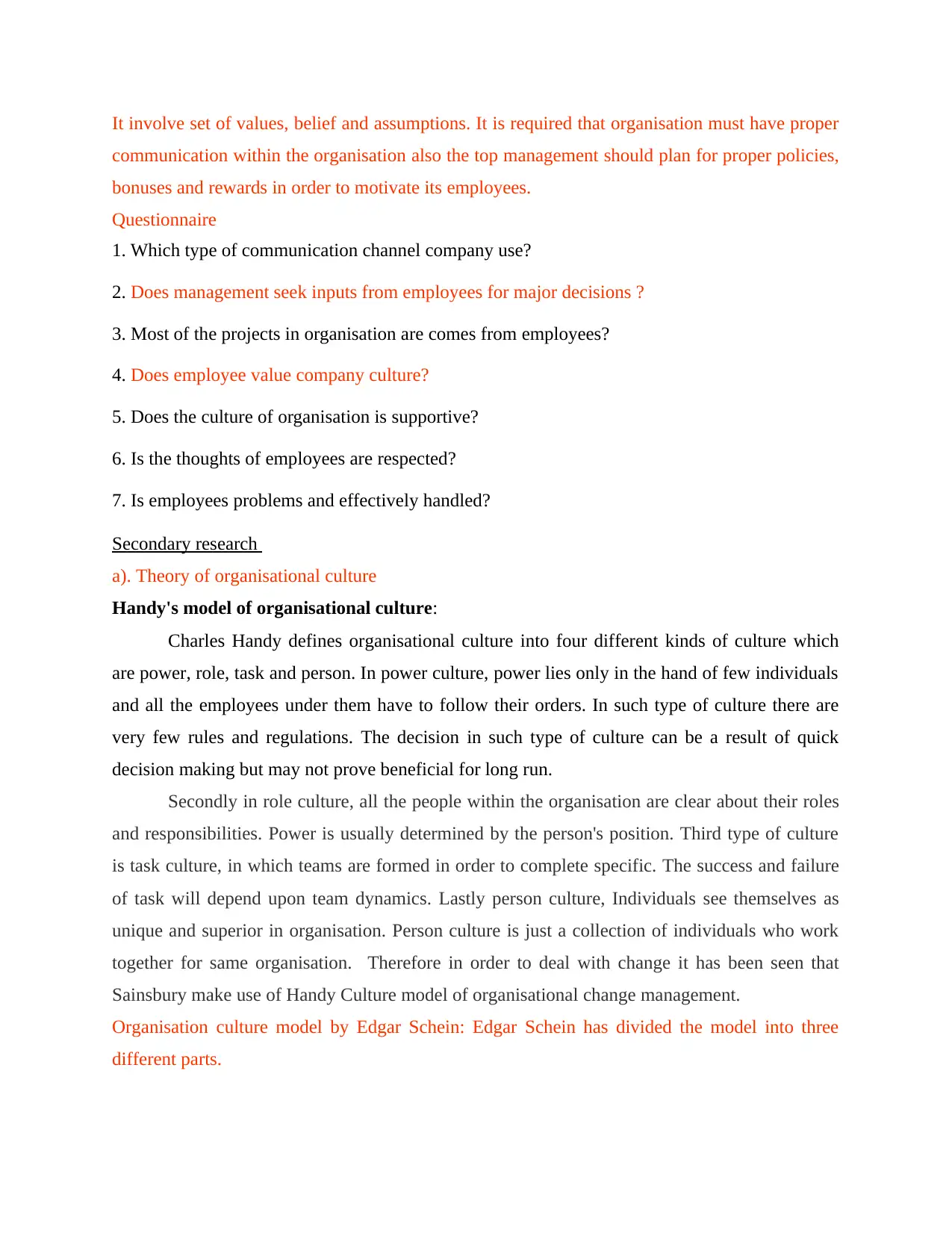
It involve set of values, belief and assumptions. It is required that organisation must have proper
communication within the organisation also the top management should plan for proper policies,
bonuses and rewards in order to motivate its employees.
Questionnaire
1. Which type of communication channel company use?
2. Does management seek inputs from employees for major decisions ?
3. Most of the projects in organisation are comes from employees?
4. Does employee value company culture?
5. Does the culture of organisation is supportive?
6. Is the thoughts of employees are respected?
7. Is employees problems and effectively handled?
Secondary research
a). Theory of organisational culture
Handy's model of organisational culture:
Charles Handy defines organisational culture into four different kinds of culture which
are power, role, task and person. In power culture, power lies only in the hand of few individuals
and all the employees under them have to follow their orders. In such type of culture there are
very few rules and regulations. The decision in such type of culture can be a result of quick
decision making but may not prove beneficial for long run.
Secondly in role culture, all the people within the organisation are clear about their roles
and responsibilities. Power is usually determined by the person's position. Third type of culture
is task culture, in which teams are formed in order to complete specific. The success and failure
of task will depend upon team dynamics. Lastly person culture, Individuals see themselves as
unique and superior in organisation. Person culture is just a collection of individuals who work
together for same organisation. Therefore in order to deal with change it has been seen that
Sainsbury make use of Handy Culture model of organisational change management.
Organisation culture model by Edgar Schein: Edgar Schein has divided the model into three
different parts.
communication within the organisation also the top management should plan for proper policies,
bonuses and rewards in order to motivate its employees.
Questionnaire
1. Which type of communication channel company use?
2. Does management seek inputs from employees for major decisions ?
3. Most of the projects in organisation are comes from employees?
4. Does employee value company culture?
5. Does the culture of organisation is supportive?
6. Is the thoughts of employees are respected?
7. Is employees problems and effectively handled?
Secondary research
a). Theory of organisational culture
Handy's model of organisational culture:
Charles Handy defines organisational culture into four different kinds of culture which
are power, role, task and person. In power culture, power lies only in the hand of few individuals
and all the employees under them have to follow their orders. In such type of culture there are
very few rules and regulations. The decision in such type of culture can be a result of quick
decision making but may not prove beneficial for long run.
Secondly in role culture, all the people within the organisation are clear about their roles
and responsibilities. Power is usually determined by the person's position. Third type of culture
is task culture, in which teams are formed in order to complete specific. The success and failure
of task will depend upon team dynamics. Lastly person culture, Individuals see themselves as
unique and superior in organisation. Person culture is just a collection of individuals who work
together for same organisation. Therefore in order to deal with change it has been seen that
Sainsbury make use of Handy Culture model of organisational change management.
Organisation culture model by Edgar Schein: Edgar Schein has divided the model into three
different parts.
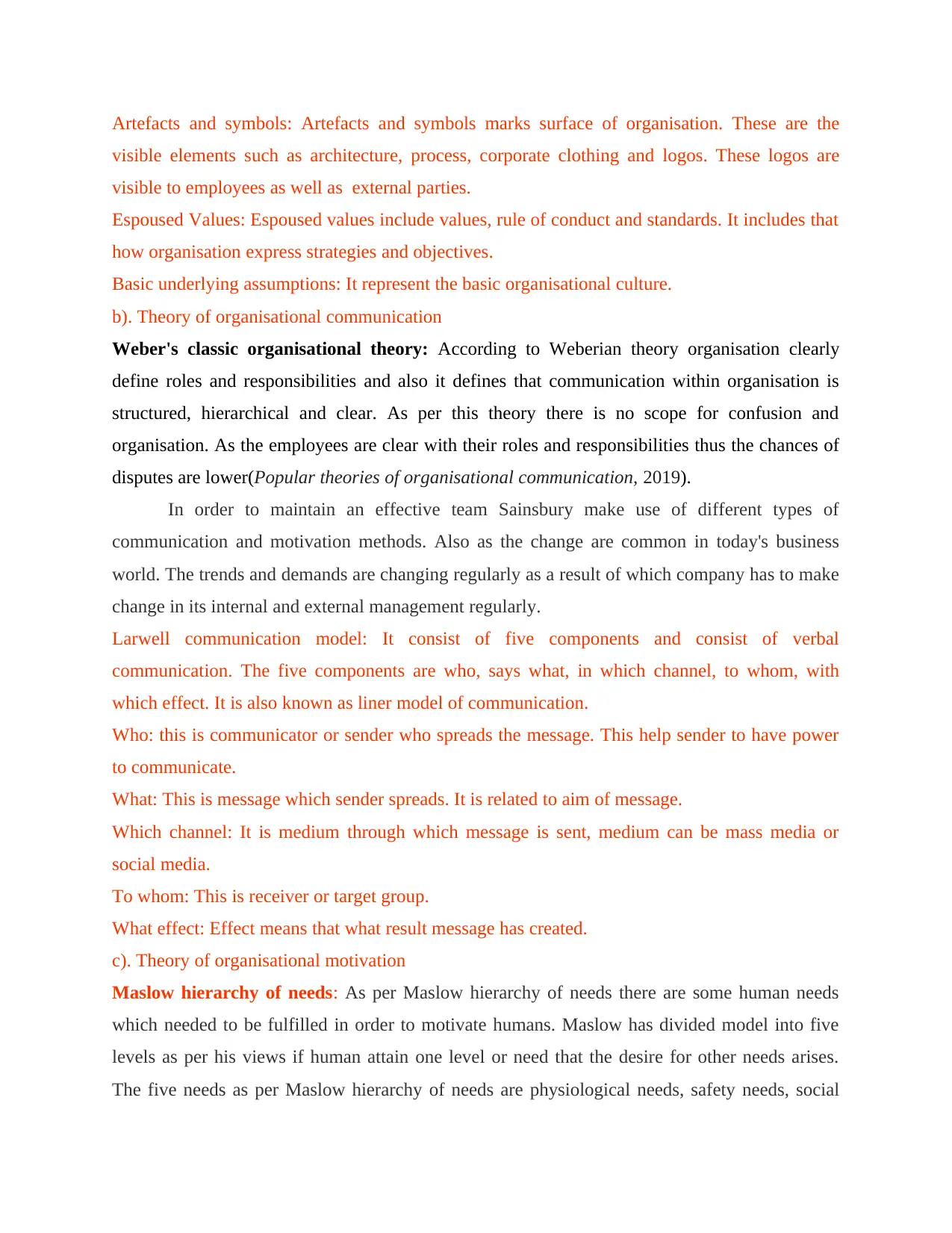
Artefacts and symbols: Artefacts and symbols marks surface of organisation. These are the
visible elements such as architecture, process, corporate clothing and logos. These logos are
visible to employees as well as external parties.
Espoused Values: Espoused values include values, rule of conduct and standards. It includes that
how organisation express strategies and objectives.
Basic underlying assumptions: It represent the basic organisational culture.
b). Theory of organisational communication
Weber's classic organisational theory: According to Weberian theory organisation clearly
define roles and responsibilities and also it defines that communication within organisation is
structured, hierarchical and clear. As per this theory there is no scope for confusion and
organisation. As the employees are clear with their roles and responsibilities thus the chances of
disputes are lower(Popular theories of organisational communication, 2019).
In order to maintain an effective team Sainsbury make use of different types of
communication and motivation methods. Also as the change are common in today's business
world. The trends and demands are changing regularly as a result of which company has to make
change in its internal and external management regularly.
Larwell communication model: It consist of five components and consist of verbal
communication. The five components are who, says what, in which channel, to whom, with
which effect. It is also known as liner model of communication.
Who: this is communicator or sender who spreads the message. This help sender to have power
to communicate.
What: This is message which sender spreads. It is related to aim of message.
Which channel: It is medium through which message is sent, medium can be mass media or
social media.
To whom: This is receiver or target group.
What effect: Effect means that what result message has created.
c). Theory of organisational motivation
Maslow hierarchy of needs: As per Maslow hierarchy of needs there are some human needs
which needed to be fulfilled in order to motivate humans. Maslow has divided model into five
levels as per his views if human attain one level or need that the desire for other needs arises.
The five needs as per Maslow hierarchy of needs are physiological needs, safety needs, social
visible elements such as architecture, process, corporate clothing and logos. These logos are
visible to employees as well as external parties.
Espoused Values: Espoused values include values, rule of conduct and standards. It includes that
how organisation express strategies and objectives.
Basic underlying assumptions: It represent the basic organisational culture.
b). Theory of organisational communication
Weber's classic organisational theory: According to Weberian theory organisation clearly
define roles and responsibilities and also it defines that communication within organisation is
structured, hierarchical and clear. As per this theory there is no scope for confusion and
organisation. As the employees are clear with their roles and responsibilities thus the chances of
disputes are lower(Popular theories of organisational communication, 2019).
In order to maintain an effective team Sainsbury make use of different types of
communication and motivation methods. Also as the change are common in today's business
world. The trends and demands are changing regularly as a result of which company has to make
change in its internal and external management regularly.
Larwell communication model: It consist of five components and consist of verbal
communication. The five components are who, says what, in which channel, to whom, with
which effect. It is also known as liner model of communication.
Who: this is communicator or sender who spreads the message. This help sender to have power
to communicate.
What: This is message which sender spreads. It is related to aim of message.
Which channel: It is medium through which message is sent, medium can be mass media or
social media.
To whom: This is receiver or target group.
What effect: Effect means that what result message has created.
c). Theory of organisational motivation
Maslow hierarchy of needs: As per Maslow hierarchy of needs there are some human needs
which needed to be fulfilled in order to motivate humans. Maslow has divided model into five
levels as per his views if human attain one level or need that the desire for other needs arises.
The five needs as per Maslow hierarchy of needs are physiological needs, safety needs, social
⊘ This is a preview!⊘
Do you want full access?
Subscribe today to unlock all pages.

Trusted by 1+ million students worldwide
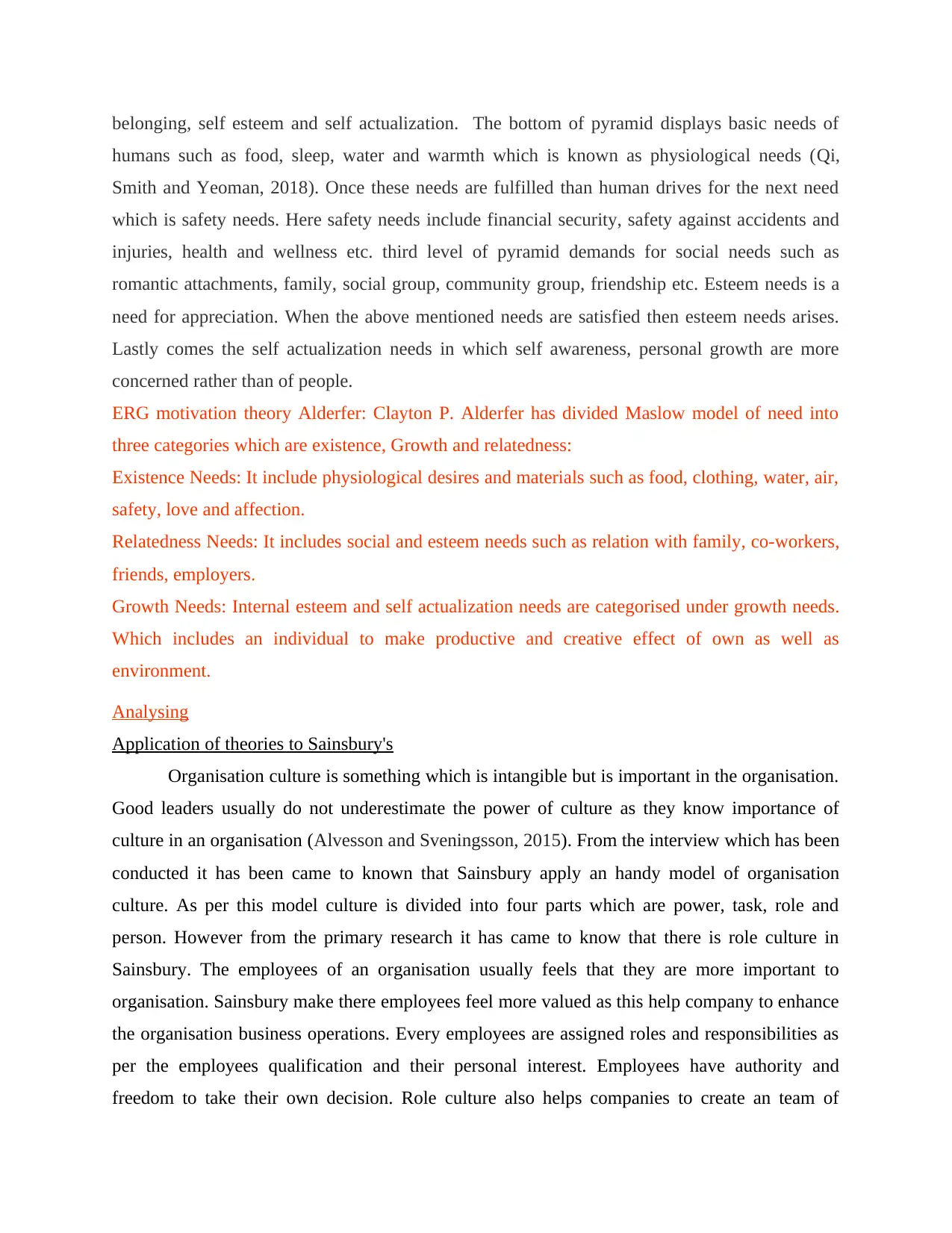
belonging, self esteem and self actualization. The bottom of pyramid displays basic needs of
humans such as food, sleep, water and warmth which is known as physiological needs (Qi,
Smith and Yeoman, 2018). Once these needs are fulfilled than human drives for the next need
which is safety needs. Here safety needs include financial security, safety against accidents and
injuries, health and wellness etc. third level of pyramid demands for social needs such as
romantic attachments, family, social group, community group, friendship etc. Esteem needs is a
need for appreciation. When the above mentioned needs are satisfied then esteem needs arises.
Lastly comes the self actualization needs in which self awareness, personal growth are more
concerned rather than of people.
ERG motivation theory Alderfer: Clayton P. Alderfer has divided Maslow model of need into
three categories which are existence, Growth and relatedness:
Existence Needs: It include physiological desires and materials such as food, clothing, water, air,
safety, love and affection.
Relatedness Needs: It includes social and esteem needs such as relation with family, co-workers,
friends, employers.
Growth Needs: Internal esteem and self actualization needs are categorised under growth needs.
Which includes an individual to make productive and creative effect of own as well as
environment.
Analysing
Application of theories to Sainsbury's
Organisation culture is something which is intangible but is important in the organisation.
Good leaders usually do not underestimate the power of culture as they know importance of
culture in an organisation (Alvesson and Sveningsson, 2015). From the interview which has been
conducted it has been came to known that Sainsbury apply an handy model of organisation
culture. As per this model culture is divided into four parts which are power, task, role and
person. However from the primary research it has came to know that there is role culture in
Sainsbury. The employees of an organisation usually feels that they are more important to
organisation. Sainsbury make there employees feel more valued as this help company to enhance
the organisation business operations. Every employees are assigned roles and responsibilities as
per the employees qualification and their personal interest. Employees have authority and
freedom to take their own decision. Role culture also helps companies to create an team of
humans such as food, sleep, water and warmth which is known as physiological needs (Qi,
Smith and Yeoman, 2018). Once these needs are fulfilled than human drives for the next need
which is safety needs. Here safety needs include financial security, safety against accidents and
injuries, health and wellness etc. third level of pyramid demands for social needs such as
romantic attachments, family, social group, community group, friendship etc. Esteem needs is a
need for appreciation. When the above mentioned needs are satisfied then esteem needs arises.
Lastly comes the self actualization needs in which self awareness, personal growth are more
concerned rather than of people.
ERG motivation theory Alderfer: Clayton P. Alderfer has divided Maslow model of need into
three categories which are existence, Growth and relatedness:
Existence Needs: It include physiological desires and materials such as food, clothing, water, air,
safety, love and affection.
Relatedness Needs: It includes social and esteem needs such as relation with family, co-workers,
friends, employers.
Growth Needs: Internal esteem and self actualization needs are categorised under growth needs.
Which includes an individual to make productive and creative effect of own as well as
environment.
Analysing
Application of theories to Sainsbury's
Organisation culture is something which is intangible but is important in the organisation.
Good leaders usually do not underestimate the power of culture as they know importance of
culture in an organisation (Alvesson and Sveningsson, 2015). From the interview which has been
conducted it has been came to known that Sainsbury apply an handy model of organisation
culture. As per this model culture is divided into four parts which are power, task, role and
person. However from the primary research it has came to know that there is role culture in
Sainsbury. The employees of an organisation usually feels that they are more important to
organisation. Sainsbury make there employees feel more valued as this help company to enhance
the organisation business operations. Every employees are assigned roles and responsibilities as
per the employees qualification and their personal interest. Employees have authority and
freedom to take their own decision. Role culture also helps companies to create an team of
Paraphrase This Document
Need a fresh take? Get an instant paraphrase of this document with our AI Paraphraser
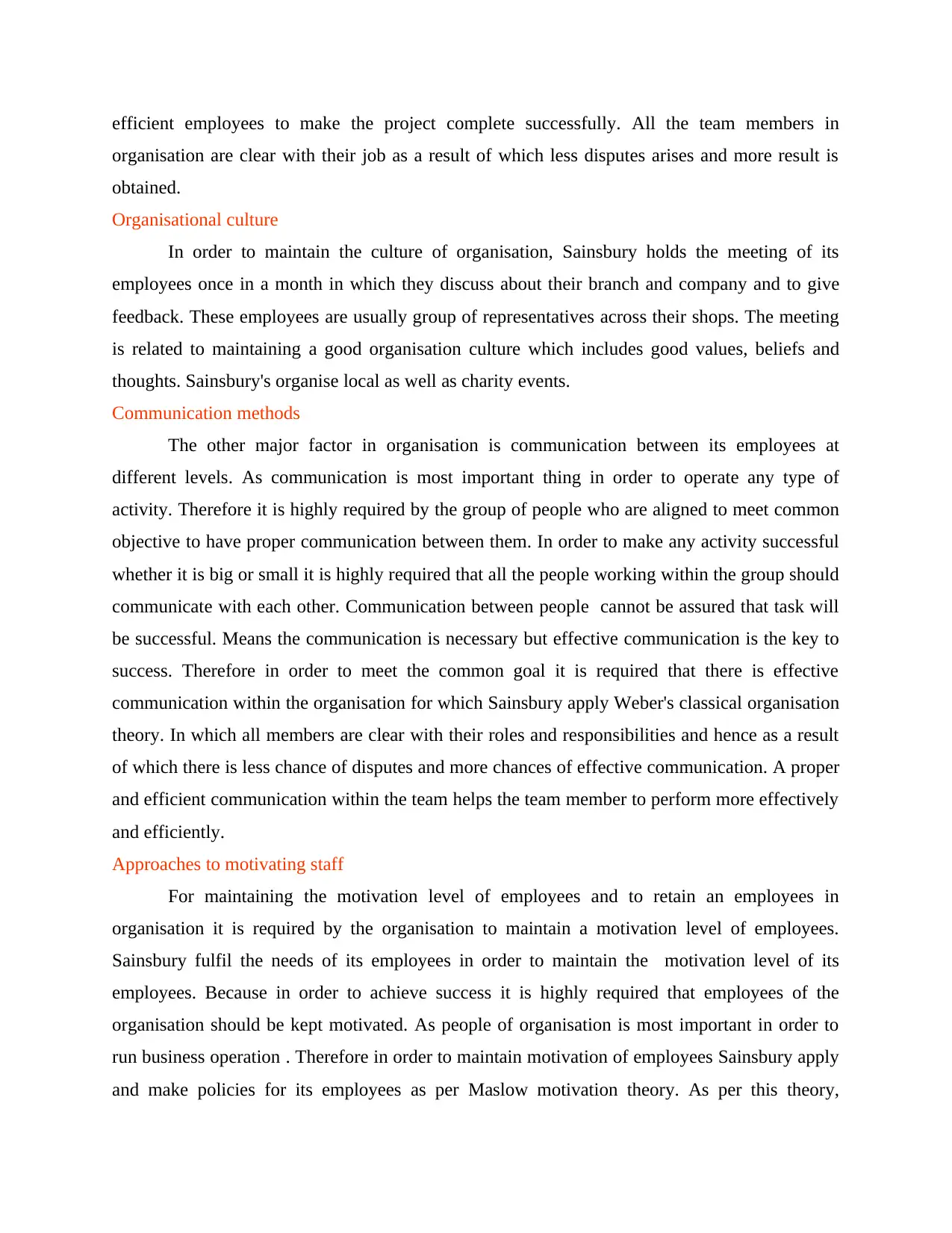
efficient employees to make the project complete successfully. All the team members in
organisation are clear with their job as a result of which less disputes arises and more result is
obtained.
Organisational culture
In order to maintain the culture of organisation, Sainsbury holds the meeting of its
employees once in a month in which they discuss about their branch and company and to give
feedback. These employees are usually group of representatives across their shops. The meeting
is related to maintaining a good organisation culture which includes good values, beliefs and
thoughts. Sainsbury's organise local as well as charity events.
Communication methods
The other major factor in organisation is communication between its employees at
different levels. As communication is most important thing in order to operate any type of
activity. Therefore it is highly required by the group of people who are aligned to meet common
objective to have proper communication between them. In order to make any activity successful
whether it is big or small it is highly required that all the people working within the group should
communicate with each other. Communication between people cannot be assured that task will
be successful. Means the communication is necessary but effective communication is the key to
success. Therefore in order to meet the common goal it is required that there is effective
communication within the organisation for which Sainsbury apply Weber's classical organisation
theory. In which all members are clear with their roles and responsibilities and hence as a result
of which there is less chance of disputes and more chances of effective communication. A proper
and efficient communication within the team helps the team member to perform more effectively
and efficiently.
Approaches to motivating staff
For maintaining the motivation level of employees and to retain an employees in
organisation it is required by the organisation to maintain a motivation level of employees.
Sainsbury fulfil the needs of its employees in order to maintain the motivation level of its
employees. Because in order to achieve success it is highly required that employees of the
organisation should be kept motivated. As people of organisation is most important in order to
run business operation . Therefore in order to maintain motivation of employees Sainsbury apply
and make policies for its employees as per Maslow motivation theory. As per this theory,
organisation are clear with their job as a result of which less disputes arises and more result is
obtained.
Organisational culture
In order to maintain the culture of organisation, Sainsbury holds the meeting of its
employees once in a month in which they discuss about their branch and company and to give
feedback. These employees are usually group of representatives across their shops. The meeting
is related to maintaining a good organisation culture which includes good values, beliefs and
thoughts. Sainsbury's organise local as well as charity events.
Communication methods
The other major factor in organisation is communication between its employees at
different levels. As communication is most important thing in order to operate any type of
activity. Therefore it is highly required by the group of people who are aligned to meet common
objective to have proper communication between them. In order to make any activity successful
whether it is big or small it is highly required that all the people working within the group should
communicate with each other. Communication between people cannot be assured that task will
be successful. Means the communication is necessary but effective communication is the key to
success. Therefore in order to meet the common goal it is required that there is effective
communication within the organisation for which Sainsbury apply Weber's classical organisation
theory. In which all members are clear with their roles and responsibilities and hence as a result
of which there is less chance of disputes and more chances of effective communication. A proper
and efficient communication within the team helps the team member to perform more effectively
and efficiently.
Approaches to motivating staff
For maintaining the motivation level of employees and to retain an employees in
organisation it is required by the organisation to maintain a motivation level of employees.
Sainsbury fulfil the needs of its employees in order to maintain the motivation level of its
employees. Because in order to achieve success it is highly required that employees of the
organisation should be kept motivated. As people of organisation is most important in order to
run business operation . Therefore in order to maintain motivation of employees Sainsbury apply
and make policies for its employees as per Maslow motivation theory. As per this theory,
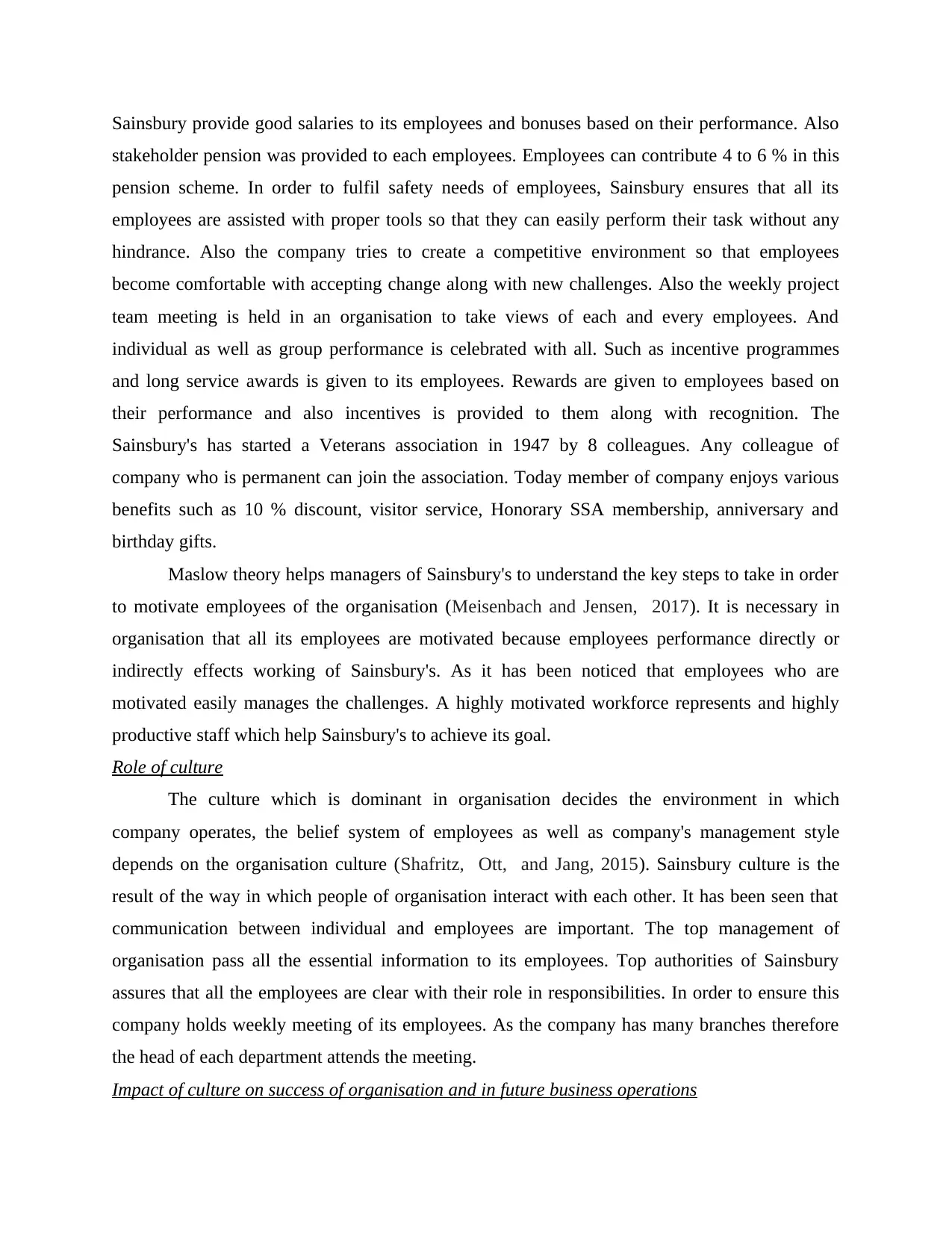
Sainsbury provide good salaries to its employees and bonuses based on their performance. Also
stakeholder pension was provided to each employees. Employees can contribute 4 to 6 % in this
pension scheme. In order to fulfil safety needs of employees, Sainsbury ensures that all its
employees are assisted with proper tools so that they can easily perform their task without any
hindrance. Also the company tries to create a competitive environment so that employees
become comfortable with accepting change along with new challenges. Also the weekly project
team meeting is held in an organisation to take views of each and every employees. And
individual as well as group performance is celebrated with all. Such as incentive programmes
and long service awards is given to its employees. Rewards are given to employees based on
their performance and also incentives is provided to them along with recognition. The
Sainsbury's has started a Veterans association in 1947 by 8 colleagues. Any colleague of
company who is permanent can join the association. Today member of company enjoys various
benefits such as 10 % discount, visitor service, Honorary SSA membership, anniversary and
birthday gifts.
Maslow theory helps managers of Sainsbury's to understand the key steps to take in order
to motivate employees of the organisation (Meisenbach and Jensen, 2017). It is necessary in
organisation that all its employees are motivated because employees performance directly or
indirectly effects working of Sainsbury's. As it has been noticed that employees who are
motivated easily manages the challenges. A highly motivated workforce represents and highly
productive staff which help Sainsbury's to achieve its goal.
Role of culture
The culture which is dominant in organisation decides the environment in which
company operates, the belief system of employees as well as company's management style
depends on the organisation culture (Shafritz, Ott, and Jang, 2015). Sainsbury culture is the
result of the way in which people of organisation interact with each other. It has been seen that
communication between individual and employees are important. The top management of
organisation pass all the essential information to its employees. Top authorities of Sainsbury
assures that all the employees are clear with their role in responsibilities. In order to ensure this
company holds weekly meeting of its employees. As the company has many branches therefore
the head of each department attends the meeting.
Impact of culture on success of organisation and in future business operations
stakeholder pension was provided to each employees. Employees can contribute 4 to 6 % in this
pension scheme. In order to fulfil safety needs of employees, Sainsbury ensures that all its
employees are assisted with proper tools so that they can easily perform their task without any
hindrance. Also the company tries to create a competitive environment so that employees
become comfortable with accepting change along with new challenges. Also the weekly project
team meeting is held in an organisation to take views of each and every employees. And
individual as well as group performance is celebrated with all. Such as incentive programmes
and long service awards is given to its employees. Rewards are given to employees based on
their performance and also incentives is provided to them along with recognition. The
Sainsbury's has started a Veterans association in 1947 by 8 colleagues. Any colleague of
company who is permanent can join the association. Today member of company enjoys various
benefits such as 10 % discount, visitor service, Honorary SSA membership, anniversary and
birthday gifts.
Maslow theory helps managers of Sainsbury's to understand the key steps to take in order
to motivate employees of the organisation (Meisenbach and Jensen, 2017). It is necessary in
organisation that all its employees are motivated because employees performance directly or
indirectly effects working of Sainsbury's. As it has been noticed that employees who are
motivated easily manages the challenges. A highly motivated workforce represents and highly
productive staff which help Sainsbury's to achieve its goal.
Role of culture
The culture which is dominant in organisation decides the environment in which
company operates, the belief system of employees as well as company's management style
depends on the organisation culture (Shafritz, Ott, and Jang, 2015). Sainsbury culture is the
result of the way in which people of organisation interact with each other. It has been seen that
communication between individual and employees are important. The top management of
organisation pass all the essential information to its employees. Top authorities of Sainsbury
assures that all the employees are clear with their role in responsibilities. In order to ensure this
company holds weekly meeting of its employees. As the company has many branches therefore
the head of each department attends the meeting.
Impact of culture on success of organisation and in future business operations
⊘ This is a preview!⊘
Do you want full access?
Subscribe today to unlock all pages.

Trusted by 1+ million students worldwide
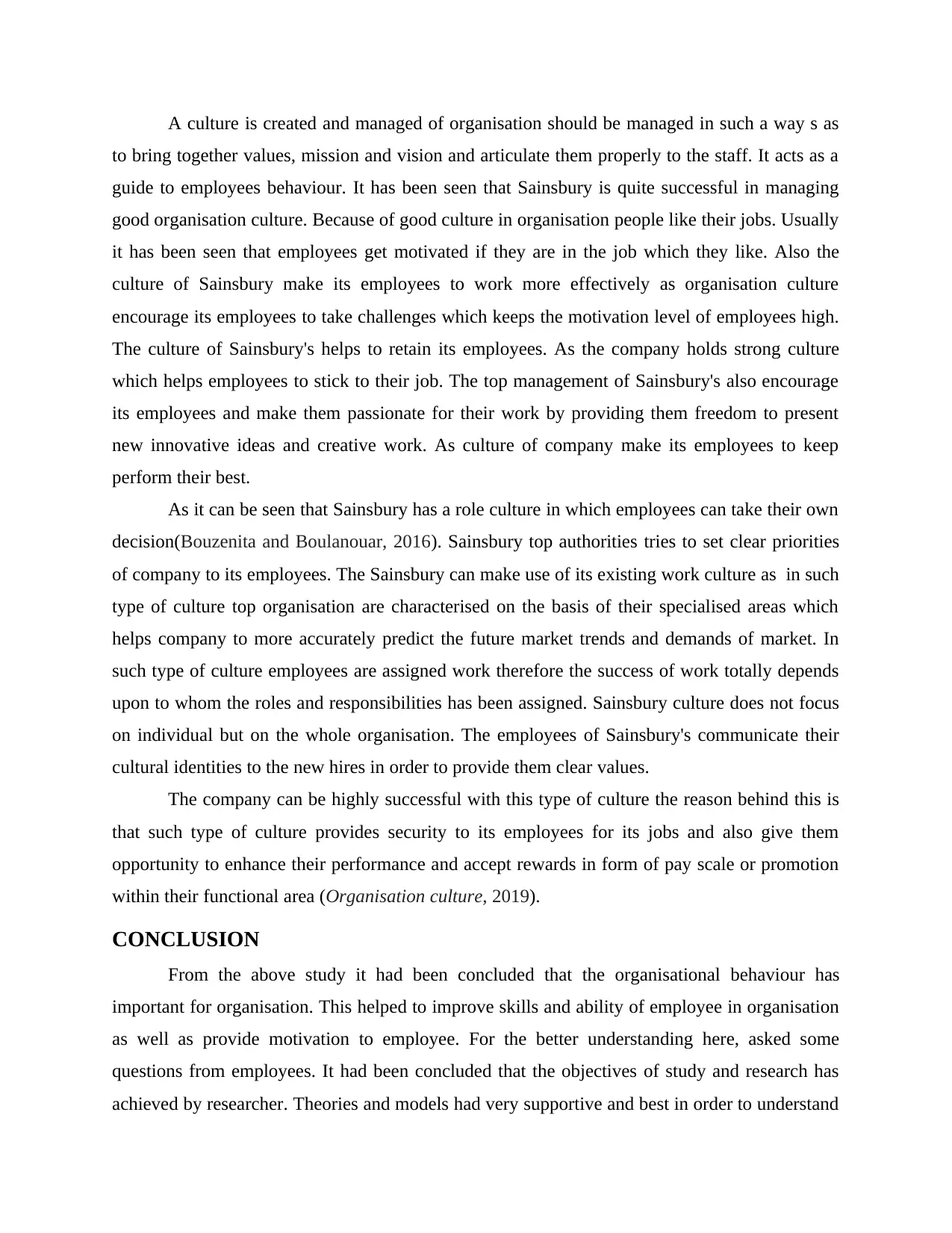
A culture is created and managed of organisation should be managed in such a way s as
to bring together values, mission and vision and articulate them properly to the staff. It acts as a
guide to employees behaviour. It has been seen that Sainsbury is quite successful in managing
good organisation culture. Because of good culture in organisation people like their jobs. Usually
it has been seen that employees get motivated if they are in the job which they like. Also the
culture of Sainsbury make its employees to work more effectively as organisation culture
encourage its employees to take challenges which keeps the motivation level of employees high.
The culture of Sainsbury's helps to retain its employees. As the company holds strong culture
which helps employees to stick to their job. The top management of Sainsbury's also encourage
its employees and make them passionate for their work by providing them freedom to present
new innovative ideas and creative work. As culture of company make its employees to keep
perform their best.
As it can be seen that Sainsbury has a role culture in which employees can take their own
decision(Bouzenita and Boulanouar, 2016). Sainsbury top authorities tries to set clear priorities
of company to its employees. The Sainsbury can make use of its existing work culture as in such
type of culture top organisation are characterised on the basis of their specialised areas which
helps company to more accurately predict the future market trends and demands of market. In
such type of culture employees are assigned work therefore the success of work totally depends
upon to whom the roles and responsibilities has been assigned. Sainsbury culture does not focus
on individual but on the whole organisation. The employees of Sainsbury's communicate their
cultural identities to the new hires in order to provide them clear values.
The company can be highly successful with this type of culture the reason behind this is
that such type of culture provides security to its employees for its jobs and also give them
opportunity to enhance their performance and accept rewards in form of pay scale or promotion
within their functional area (Organisation culture, 2019).
CONCLUSION
From the above study it had been concluded that the organisational behaviour has
important for organisation. This helped to improve skills and ability of employee in organisation
as well as provide motivation to employee. For the better understanding here, asked some
questions from employees. It had been concluded that the objectives of study and research has
achieved by researcher. Theories and models had very supportive and best in order to understand
to bring together values, mission and vision and articulate them properly to the staff. It acts as a
guide to employees behaviour. It has been seen that Sainsbury is quite successful in managing
good organisation culture. Because of good culture in organisation people like their jobs. Usually
it has been seen that employees get motivated if they are in the job which they like. Also the
culture of Sainsbury make its employees to work more effectively as organisation culture
encourage its employees to take challenges which keeps the motivation level of employees high.
The culture of Sainsbury's helps to retain its employees. As the company holds strong culture
which helps employees to stick to their job. The top management of Sainsbury's also encourage
its employees and make them passionate for their work by providing them freedom to present
new innovative ideas and creative work. As culture of company make its employees to keep
perform their best.
As it can be seen that Sainsbury has a role culture in which employees can take their own
decision(Bouzenita and Boulanouar, 2016). Sainsbury top authorities tries to set clear priorities
of company to its employees. The Sainsbury can make use of its existing work culture as in such
type of culture top organisation are characterised on the basis of their specialised areas which
helps company to more accurately predict the future market trends and demands of market. In
such type of culture employees are assigned work therefore the success of work totally depends
upon to whom the roles and responsibilities has been assigned. Sainsbury culture does not focus
on individual but on the whole organisation. The employees of Sainsbury's communicate their
cultural identities to the new hires in order to provide them clear values.
The company can be highly successful with this type of culture the reason behind this is
that such type of culture provides security to its employees for its jobs and also give them
opportunity to enhance their performance and accept rewards in form of pay scale or promotion
within their functional area (Organisation culture, 2019).
CONCLUSION
From the above study it had been concluded that the organisational behaviour has
important for organisation. This helped to improve skills and ability of employee in organisation
as well as provide motivation to employee. For the better understanding here, asked some
questions from employees. It had been concluded that the objectives of study and research has
achieved by researcher. Theories and models had very supportive and best in order to understand
Paraphrase This Document
Need a fresh take? Get an instant paraphrase of this document with our AI Paraphraser
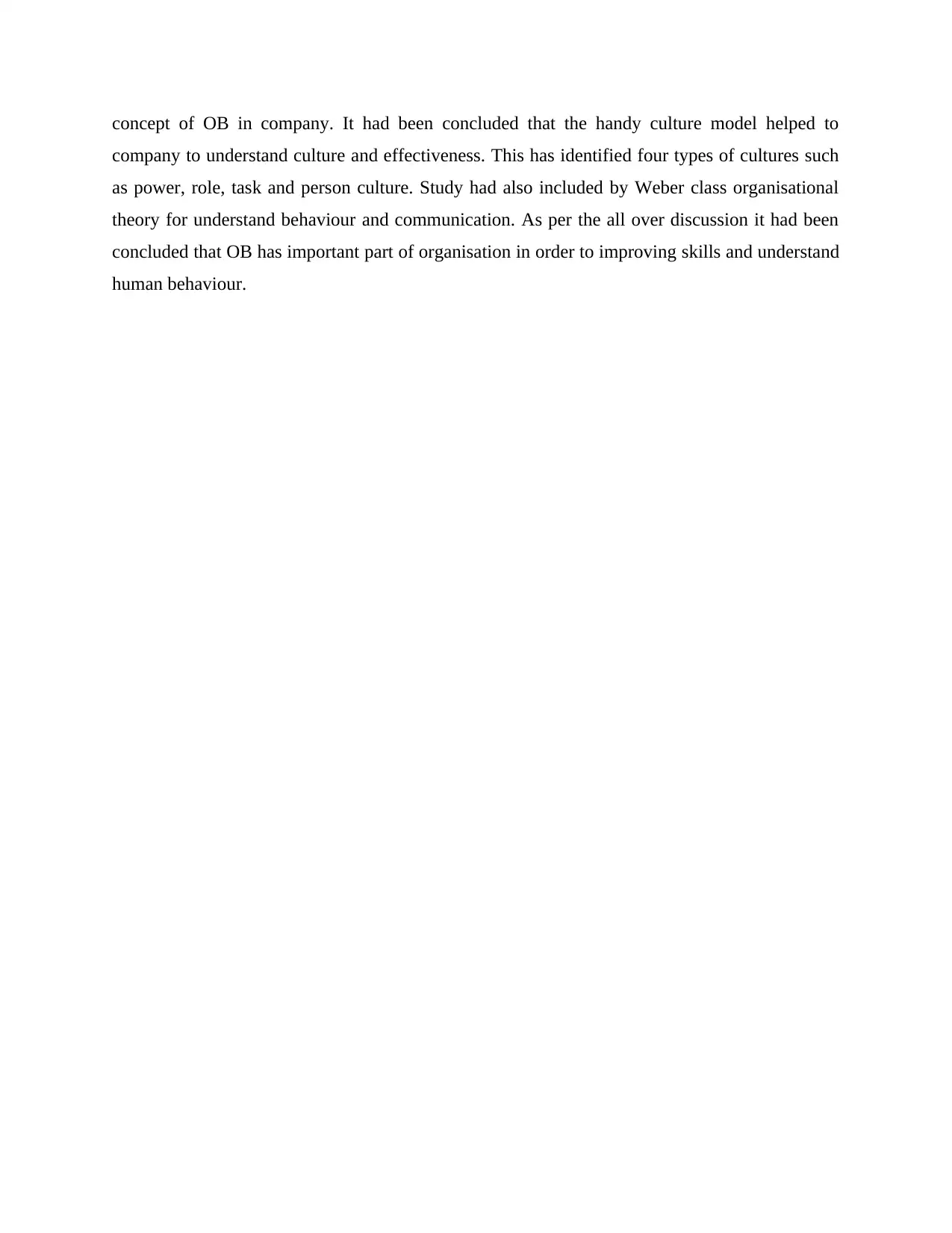
concept of OB in company. It had been concluded that the handy culture model helped to
company to understand culture and effectiveness. This has identified four types of cultures such
as power, role, task and person culture. Study had also included by Weber class organisational
theory for understand behaviour and communication. As per the all over discussion it had been
concluded that OB has important part of organisation in order to improving skills and understand
human behaviour.
company to understand culture and effectiveness. This has identified four types of cultures such
as power, role, task and person culture. Study had also included by Weber class organisational
theory for understand behaviour and communication. As per the all over discussion it had been
concluded that OB has important part of organisation in order to improving skills and understand
human behaviour.
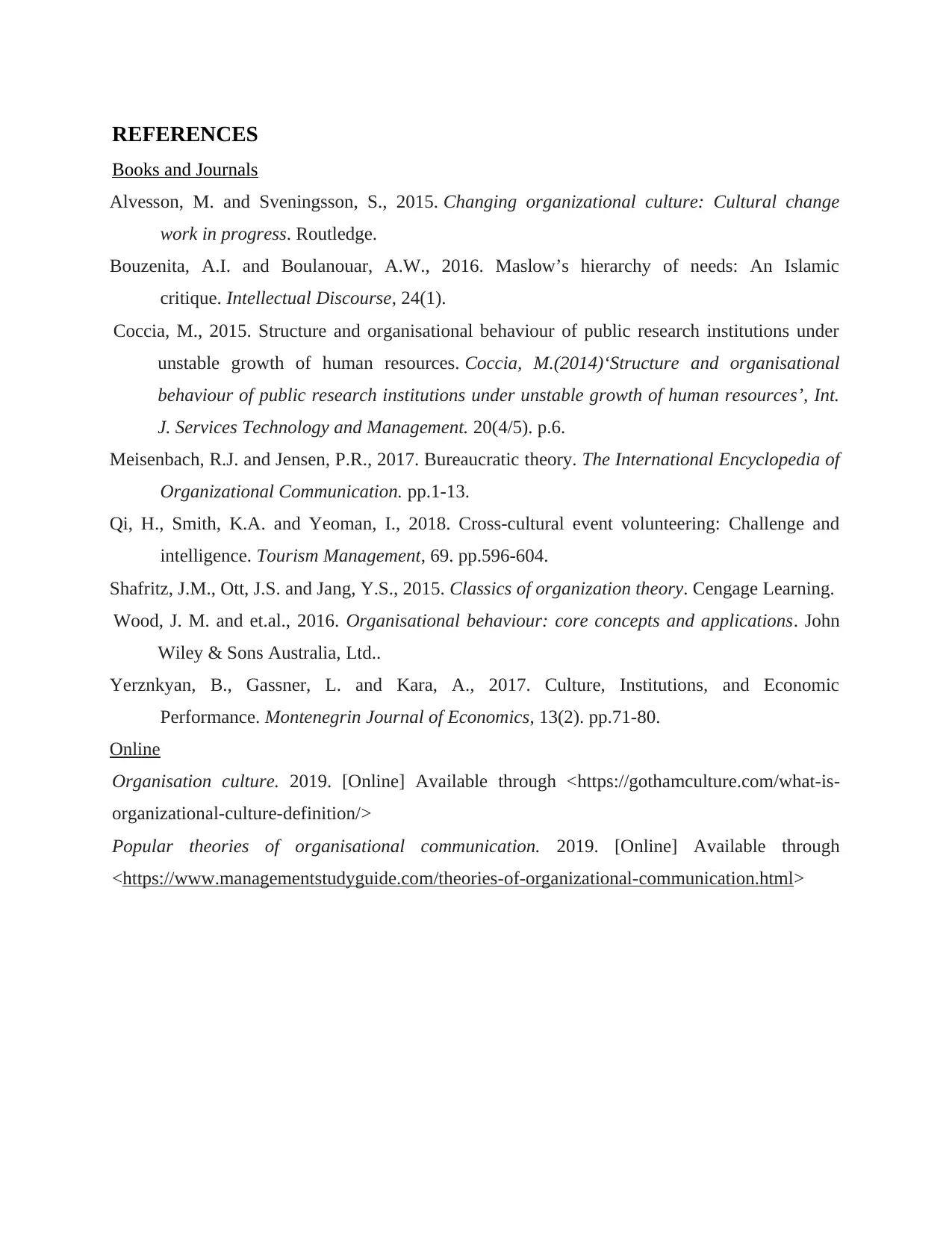
REFERENCES
Books and Journals
Alvesson, M. and Sveningsson, S., 2015. Changing organizational culture: Cultural change
work in progress. Routledge.
Bouzenita, A.I. and Boulanouar, A.W., 2016. Maslow’s hierarchy of needs: An Islamic
critique. Intellectual Discourse, 24(1).
Coccia, M., 2015. Structure and organisational behaviour of public research institutions under
unstable growth of human resources. Coccia, M.(2014)‘Structure and organisational
behaviour of public research institutions under unstable growth of human resources’, Int.
J. Services Technology and Management. 20(4/5). p.6.
Meisenbach, R.J. and Jensen, P.R., 2017. Bureaucratic theory. The International Encyclopedia of
Organizational Communication. pp.1-13.
Qi, H., Smith, K.A. and Yeoman, I., 2018. Cross-cultural event volunteering: Challenge and
intelligence. Tourism Management, 69. pp.596-604.
Shafritz, J.M., Ott, J.S. and Jang, Y.S., 2015. Classics of organization theory. Cengage Learning.
Wood, J. M. and et.al., 2016. Organisational behaviour: core concepts and applications. John
Wiley & Sons Australia, Ltd..
Yerznkyan, B., Gassner, L. and Kara, A., 2017. Culture, Institutions, and Economic
Performance. Montenegrin Journal of Economics, 13(2). pp.71-80.
Online
Organisation culture. 2019. [Online] Available through <https://gothamculture.com/what-is-
organizational-culture-definition/>
Popular theories of organisational communication. 2019. [Online] Available through
<https://www.managementstudyguide.com/theories-of-organizational-communication.html>
Books and Journals
Alvesson, M. and Sveningsson, S., 2015. Changing organizational culture: Cultural change
work in progress. Routledge.
Bouzenita, A.I. and Boulanouar, A.W., 2016. Maslow’s hierarchy of needs: An Islamic
critique. Intellectual Discourse, 24(1).
Coccia, M., 2015. Structure and organisational behaviour of public research institutions under
unstable growth of human resources. Coccia, M.(2014)‘Structure and organisational
behaviour of public research institutions under unstable growth of human resources’, Int.
J. Services Technology and Management. 20(4/5). p.6.
Meisenbach, R.J. and Jensen, P.R., 2017. Bureaucratic theory. The International Encyclopedia of
Organizational Communication. pp.1-13.
Qi, H., Smith, K.A. and Yeoman, I., 2018. Cross-cultural event volunteering: Challenge and
intelligence. Tourism Management, 69. pp.596-604.
Shafritz, J.M., Ott, J.S. and Jang, Y.S., 2015. Classics of organization theory. Cengage Learning.
Wood, J. M. and et.al., 2016. Organisational behaviour: core concepts and applications. John
Wiley & Sons Australia, Ltd..
Yerznkyan, B., Gassner, L. and Kara, A., 2017. Culture, Institutions, and Economic
Performance. Montenegrin Journal of Economics, 13(2). pp.71-80.
Online
Organisation culture. 2019. [Online] Available through <https://gothamculture.com/what-is-
organizational-culture-definition/>
Popular theories of organisational communication. 2019. [Online] Available through
<https://www.managementstudyguide.com/theories-of-organizational-communication.html>
⊘ This is a preview!⊘
Do you want full access?
Subscribe today to unlock all pages.

Trusted by 1+ million students worldwide
1 out of 18
Related Documents
Your All-in-One AI-Powered Toolkit for Academic Success.
+13062052269
info@desklib.com
Available 24*7 on WhatsApp / Email
![[object Object]](/_next/static/media/star-bottom.7253800d.svg)
Unlock your academic potential
Copyright © 2020–2025 A2Z Services. All Rights Reserved. Developed and managed by ZUCOL.





